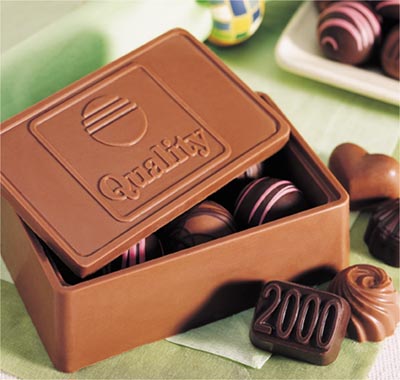Facts about Chocolate
This is the black/brown/white yummy (very sweet) thing that so many millions of people around the world totally dig! I dig chocolate - Hersheys and Reese's are my favourites! Oh well... Guylian shells are nice too... ahh *salivating*. Well, here's a lowdown on the brown stuff... not turd... CHOCOLATE!

1. Chocolate is one of the most popular foods around and is highly unlikely to ever go out of fashion.
2. The word 'Chocolate' comes from the Aztec word, 'cacahuatl' or ‘xocolatl’. This means 'bitter water'.
3. Chocolate is derived from Cocoa Beans. It was Cacao originally, but became Cocoa as a result of misspelling.
4. Cocoa Trees require warm, moist climates and are largely found in West Africa - Ghana, the Ivory Coast and Nigeria. The scientific term for the Cocoa Tree is 'Theobroma Cacao'. This is the Greek term for 'Food for the Gods'.
5. Cocoa Trees produce pods and each pod contains about 20 to 50 Cocoa Beans. There are different varieties of Cocoa Beans with different flavors, and, just like different grapes are used to make different wines, different Cocoa Beans are used to make different kinds of Chocolates. Cocoa Beans are fermented, dried, roasted, and ground before being used to produce chocolate.
6. The Mayans and Aztecs believed that the Cocoa Beans originated from Paradise and would bring wisdom and power to anyone consuming them.
7. The Aztecs mixed Chocolate with Chilies, Cornmeal, and Hallucinogenic Mushroom. It was a bitter brew!
8. The precious Cocoa Beans were used as a currency and as a unit of calculation in the Mayan and Aztec Cultures.
9. Emperor Montezuma of Mexico partook a Chocolate drink before entering his harem. This gave rise to the notion of Chocolate having aphrodisiac properties. The Italian adventurer Giacomo Casanova was another fellow who subscribed to this notion. There is some truth to the idea though, since Chocolate contains hundreds of chemicals including the feel-good stimulants - Caffeine, Theobromine, and Phenyethylamine.
10. However the amount of Caffeine in Chocolate is very little - about 5 to 10 milligrams of caffeine in one ounce of bittersweet chocolate, 5 milligrams in milk chocolate, and 10 milligrams in a six-ounce cup of cocoa. Compare this to 100-150 milligrams found in a cup of coffee.
11. Theobromine helps boost low blood-sugar levels and another chemical, Chromium, helps to control blood sugar.
12. Theobromine, however, is highly toxic to dogs, cats, and other household pets. It overstimulates their cardiac and nervous systems, and can cause instant death.
13. For humans though, Chocolate is a wonderful energy source. Napoleon supposedly carried along Chocolate on his military campaigns, and always ate it to restore energy. Nowadays Sports-persons are often given Chocolate energy bars after sporting activities to restore carbohydrates.
14. Even though Chocolate is high in fat, it does not appear to raise blood cholesterol.
15. Despite the popular, lingering myth, Chocolate does not cause acne. Acne is usually due to an improper diet or a hormone imbalance.
16. Also, contrary to another popular myth, Chocolates are not responsible for causing headaches. Headaches, again, have different reasons - stress, hunger, irregular sleep patterns, and hormone changes.
17. Allergies to chocolate are very uncommon.
17. Cocoa butter, which is the fat extract from roasted and crushed Cocoa Beans, is often used as a massage cream.
18. It is also used to make White, Caffeine-less Chocolate.
19. Cocoa Beans were first brought to Europe by the Spanish Conquistadors in 1528.
20. Chocolate soon became very popular and was taken as a sweet drink with sugar and vanilla.
21. Henri Nestle of Switzerland was the first to create Milk Chocolate by adding condensed milk to the mixture when making chocolate bars.
22. Rudolphe Lindt of Switzerland in 1879 was the first to develop a method to give Chocolate a smooth consistency.
23. Chocolate has over 500 flavor components. This is double the amount found in strawberry and vanilla.
24. Chocolate is a great economy booster. Annual world consumption of cocoa beans averages approximately 600,000 tons per year. Consumers worldwide spend more than $20 billion a year on Chocolate.
25. Chocolate syrup was used for blood in the famous shower scene in Alfred Hitchcock's movie, "Psycho". This scene, which is of 45 seconds, actually took 7 days to shoot.
26. Chocolate appears in literature - 'Charlie and the Chocolate Factory' by Roald Dahl, ‘Like Water for Chocolate' by Laura Esquivel, and 'Chocolat' by Joanne Harris.
*taken from buzzle.com

0 Comments:
Post a Comment
Subscribe to Post Comments [Atom]
<< Home